|
Once you are confident of betting
with level stakes you can think
about using a staking plan to increase
your profits. Staking plans can
mean the difference between a small
profit and a large profit. Do you
find most Staking plans difficult
to understand and hard to use? We
have completed workouts for several
staking plans that are easy to use.
As you can see from the results
shown, sticking to a staking plan
can pay off for you in the long
run. Although the staking article was written in 2001, the same results are being achieved today and to check up to date results for our Premium Services click here.
Betting
Level Stakes
We all know how to do this one.
Simply decide on a bet size that
you can safely work with, then bet
the same amount on every selection.
This plan has the advantage of not
requiring any working out, the bet
size remains constant. All you have
to do is keep track of your returns.
You can see on the graph included
here that, starting with a bank
of $500 and betting $10 on each
selection, your bank could have
risen to $1848 over the last 15
months. That makes a profit of $1348
from just betting $10 on every selection.
You could be happy with that, but
what if you could have more profit
from the same selections using a
different staking plan? Who wouldn't
be interested in that? We'll show
you the results using the Two Percent
Staking Plan, The Money Factory,
Betting 10% For 10 Bets and Betting
5% For 20 Bets. All these plans
have simple and easy to follow rules,
but have the advantage of greater
profits than when betting level
stakes.
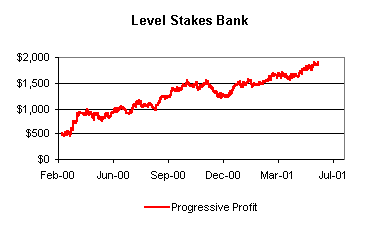
The
Two Percent Staking Plan
One of the easiest staking plans
you can use. This plan involves
betting 2% of your bank. So if you
started with a bank of $1000, your
first bet would be for $20. You
can use this staking plan by making
adjustments after each selection
or after each day. This depends
on how much time you have available,
either way works well. If we make
the adjustment after each day, we
need to look at our bank and work
out 2% of that. If 2% of the new
bank is greater than our previous
bet size, then this is our new amount
to bet. If 2% of the new bank is
less than our previous bet size,
then we continue with our previous
bet amount. It is important to never
lower your bet size.
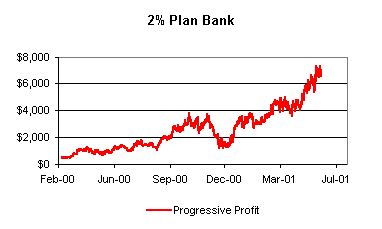
We have worked with this staking
plan using everything from 1% to
5% of our bank. Our results have
shown that using 4% and 5% was not
viable, these banks busted after
making profits of $23000 and $57000
respectively. With 3% the bank reached
rock bottom, so this option wasn't
viable either. With 2% the maximum
drawdown was 67% after the bank
reached $3500. This is quite acceptable.
As shown in the graph above, starting
with a bank of $500 after the last
16 months we finished at $6545.
That gives us a profit of $6045,
which is significantly higher than
when betting level stakes. The 1%
version could be used for the more
conservative bettor, this bank has
a maximum drawdown of 43% after
reaching $1400. The final result
for this bank was $1864, that makes
a profit of $1364. You will notice
that this is a similar profit to
what we achieved with level stakes.
Over a longer time period the 1%
Plan would obtain higher profits
than when betting level stakes,
but our starting bet was only $5.
So we can see that we are easily
able to make a good profit using
the Two Percent Staking Plan. But
still, there are other options.
We recommend the Money Factory.
The
Money Factory
This is slightly more complicated
than the Two Percent Plan. You will
see that the profits that can be
achieved greatly outweigh the time
required to operate this plan. For
this plan, you start with a target
of say $250, and a divisor of 5.
This makes your first bet $50 ($250/5).
If the bet loses, then your target
is now $300, so your next bet is
$60 ($300/5). If this bet wins and
pays $2.20, then you take away your
profit from your target and reduce
your divisor by the TAB price minus
one. That means your target is now
$228, and your divisor is now 3.8.
Your next bet will be $60 ($228/3.8).
You can choose to stop once you
make any profit at all or once you
have reached target. If you have
not reached your target after ten
bets, then you add 5 to the divisor.
This ensures that your bet sizes
remain manageable. We have worked
through the results stopping once
your target drops to less than $100.
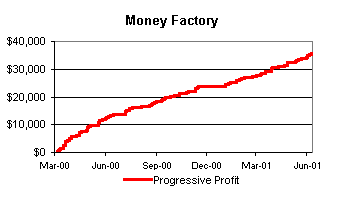
For the last 16 months, you could
have made a profit of $35,675, bearing
in mind you would need a bank of
$10,000 to operate at this level.
At one stage the target reached
$7,653. One way to make this plan
easier to use is to have several
targets running at once. This way
you don't have to watch the results
through the day, you just need to
check your results at the end of
the day. Working with ten columns
you will find that most days you
can place your bets in the morning
and not have to do anything until
the next morning when you enter
your results and work out your next
bets. But there are other plans
available to suit those who would
like to invest less capital. You
don't need to have a bank of $10,000
to still make a comfortable profit.
10%
For Bets
This staking plan has some similarities
to the Two Percent Plan. You start
with a bank of $500, and you bet
10% of the bank for 10 bets. Regardless
of the outcome, you start again
on your eleventh bet with another
$500 and $50 bets. This method makes
this plan very easy to use. For
the past 15 months results, we achieved
profits of $6,649. This is shown
in the graph below. With this plan
you may lose a bank and need to
have another in reserve. There are
also variations to this plan that
will help eliminate this from occurring.
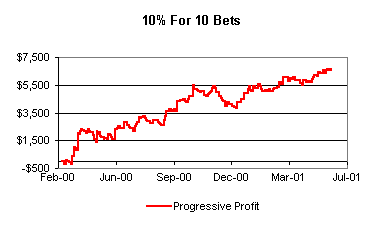
One of those variations is betting
5% for 20 bets. The results for
this were similar to betting 10%
for 10 bets. Using 5% for 20 bets
we achieved a profit of $3,318 for
the past 15 months. The profit on
turnover for 10% for 10 was 8.51%.
The profit on turnover for 5% for
20 was 8.55%. So you can see that
the two variations have similar
results given their different outlays.
Here's an example of a 10% Bank
for ten bets.
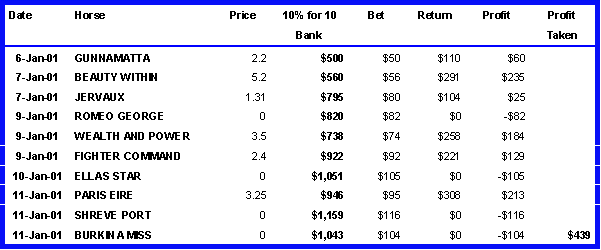
|